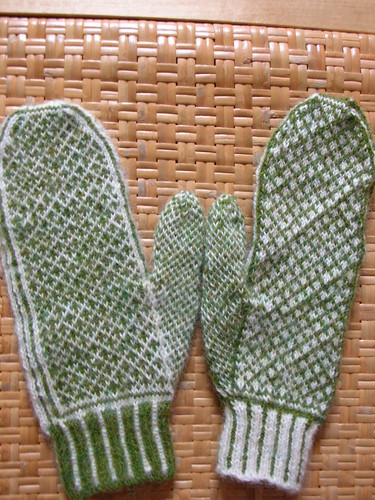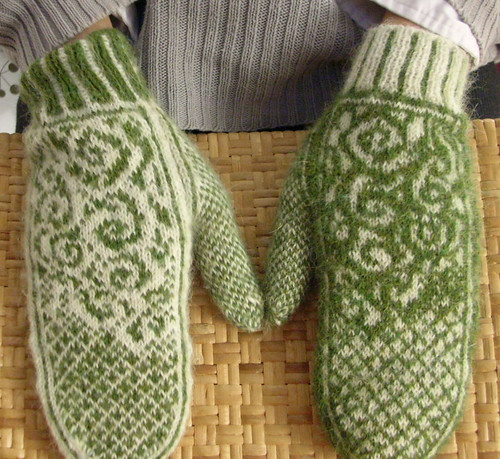Pattern: Anemoi Mittens by Eunny Jang (who unfortunately stopped blogging, but her patterns are still available on her old blog or via Ravelry)
Yarn: Drops Alpaca, 100 % alpaca, recommended gauge: 23 stitches x 30 cm = 10 cm x 10 cm
Color: green (a nice pea green) and white (natural)
Price: was in my stash, but I think it's about 3-4 Euros
Amount: less than one ball in each color
Needles: 2.00 mm and 2.25 mm
Gauge: they fit, but I think for mittens they should have more ease to be warm
Dimensions: Small
Modifications: None
Comments:
The yarn:
The yarn does not strike me as of great quality. I used the same yarn once to crochet a small shrug/vest. After blocking I realized that it was too small and so frogged it. I then realized that the yarn had become really sticky and you had to tear at it in order to undo the stitches. It was the same thing with the mittens, once you knit it, you better not rip back. This is one of the few yarns I have worked with that seem to felt just by looking at them. It also became very fuzzy after washing.
The color range is amazing though. I really like the green, it has all kinds of light and dark speckles of green in it. Not a boring yarn to look at. And it's also soft and nice to touch.
There's some bleeding when you wash it.

The gauge:
I just measured and I get 20 stitches over 5 cm, which means I managed to press a lot more stitches into a cm than what the band said. This is a bit weird, but the mittens look ok to me. I expected them to be a bit wider though since I didn't swatch. They fit, but I read that mittens are supposed to have a bit of ease to give the best insulation against the cold. I think next time I would use bigger needles.
Fair isle and yarn dominance:
If you want to do fair isle you need to know what yarn dominance means. The first time I heard about it was on Nona's blog. I didn't have any intention of doing fair isle at that time, but kept this piece of information in the back of my mind. I learned that:
1. One color will dominate and pop out more than the other (take a look at her two swatches that she shows for comparison).
2. It is the yarn that is carried below the other that will pop out more.
If you didn't get point 2, neither did I... But I like that I'm so smart and remember things that I initially didn't need, because when I did want to do fair isle, I remembered this thing about yarn dominance. Since I didn't get it completely then (not so smart maybe? :D), I had to investigate this issue further.
Reading Tia Judy and Très Chic Veronique helped me understand what was going on a bit more.
Then I saw a commentator at meangirl's blog say that she was an English knitter (like me!) holding the contrast yarn in her left hand and the main color in the right hand. I thought that as I had no clue what to do I should follow her like a good lemming and do what she did. I also learned from the blog post that you are not supposed to change the hand that carries the colors at your whim.
3. One hand, one color. Don't change. (We're talking about two color knitting and I use both hands instead of one hand to carry the yarn.)
I also consulted my favorite knitting blog, TECHknitter, that never fails me when I'm in dire need of a thorough and detailed explanation of a knitting technique. She explained in one of her comments that in her opinion it didn't really matter that much if the yarn was carried from below or above unless you have can achieve an even tension with both hands (of course, we all can), but that a color would pop out more when the hand that carries the color is your unfamiliar knitting hand. The tension will be looser and the yarn will be more prominent to see.
4. Carry the contrast color (=foreground color, pattern color, the color that you want to pop out) in the hand that you usually don't use for knitting.
If I understood it right, when you're an English knitter, you're on the safe side twice, because when you carry the contrast color with your weaker hand, the left hand, the yarn will also automatically ride below the other color.
Meangirl also has a nice picture tutorial for weaving in the background color (=main color, the color that predominates and is used most often) yarn when you have to carry it over a longer stretch of stitches. When you want to to weave in the contrast color, you have to wrap the contrast color anticlockwise and then the background color and then unwrap the contrast color. The background color stitch will be mounted with the back leg first, but in the next row simply knit into the backloop.
Useful video from Knitpicks that shows how to carry yarn: http://www.youtube.com/watch?v=O2L4Fo82zwk
After knitting the first mitten went so smoothly I thought I didn't need to pay that much attention to the tension with the second mitten and that if problems did occur blocking would resolve them all. The somewhat crappy looking mitten on the left side (I stole the idea with the reversed colors from Très Chic Veronique. Second-sock-syndrome has a cousin - second-mitten-syndrome) is proof of my sloppiness. You might notice that the cuff seems to look shorter and smaller. That's because it is. :( I had to reknit the cuff of the right mitten a couple of time and at that time I still tugged and checked that I wasn't knitting too tightly, etc. The cuff of the left mitten I knit once.


The blocked mitten looks a bit bigger, but usually knitted items shrink a bit after blocking. They are both the same size now.

After blocking:

Well, blocking did resolve nearly everything, except for the very very very tight cuff and the very prominent green. It seems the tension on my left hand was a lot looser than when I knit the right mitten.
Cast-on:
For the cast-on I did a tubular cast-on. I followed Ysolda's instruction for a long-tail tubular cast-on, but I'm not sure if in the end I did the same thing as she did... She said that it differed from the Italian method where you can pull out the yarn, while here the strand that creates the stitches would alternate. Well, my impression was that there was only one strand that created the loops, in the front and in the back and I have been able to pull out the yarn. I also didn't start with a slip knot (I used the needle to pull at the yarn between my fingers and then started making the stitches).
Edit: I was researching how to do a better tubular cast-on for a different project and just found this post by TECHknitter. I thought I had been following Ysolda's instruction, but actually what I did resembles more what TECHknitter did.
Overall I like the mittens. Nice quick project and I learned a couple of new things.
Thursday, January 29, 2009
Finished: Anemoi Mittens
Eingestellt von projektleiterin um 6:17:00 PM
Labels: alpaca, Anemoi mittens, Eunny Jang, fair isle, mittens
Subscribe to:
Post Comments (Atom)








2 Kommentare:
Looks great and good infos for me to keep in mind when I'm ready to tackle fair-isle. Although I wonder whether yarn dominance has much anything to do with double knitting or not.
Anyway, I like the white on green one better than the green on white one.
Would love to "inspect" them closer on Sunday...if you're popping around. :-)
Yeah, I will wear them tomorrow! :D
Post a Comment